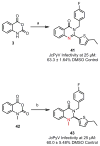Structural optimization of a retrograde trafficking inhibitor that protects cells from infections by human polyoma- and papillomaviruses
- PMID: 25087050
- PMCID: PMC4378546
- DOI: 10.1016/j.bmc.2014.06.053
Structural optimization of a retrograde trafficking inhibitor that protects cells from infections by human polyoma- and papillomaviruses
Abstract
Human polyoma- and papillomaviruses are non-enveloped DNA viruses that cause severe pathologies and mortalities. Under circumstances of immunosuppression, JC polyomavirus causes a fatal demyelinating disease called progressive multifocal leukoencephalopathy (PML) and the BK polyomavirus is the etiological agent of polyomavirus-induced nephropathy and hemorrhagic cystitis. Human papillomavirus type 16, another non-enveloped DNA virus, is associated with the development of cancers in tissues like the uterine cervix and oropharynx. Currently, there are no approved drugs or vaccines to treat or prevent polyomavirus infections. We recently discovered that the small molecule Retro-2(cycl), an inhibitor of host retrograde trafficking, blocked infection by several human and monkey polyomaviruses. Here, we report diversity-oriented syntheses of Retro-2(cycl) and evaluation of the resulting analogs using an assay of human cell infections by JC polyomavirus. We defined structure-activity relationships and also discovered analogs with significantly improved potency as suppressors of human polyoma- and papillomavirus infection in vitro. Our findings represent an advance in the development of drug candidates that can broadly protect humans from non-enveloped DNA viruses and toxins that exploit retrograde trafficking as a means for cell entry.
Keywords: Dihydroquinazolinone; Papillomavirus; Polyomavirus; Retrograde trafficking; SAR.
Copyright © 2014 Elsevier Ltd. All rights reserved.
Figures





References
-
- Binet I, Nickeleit V, Hirsch HH, Prince O, Dalquen P, Gudat F, Mihatsch MJ, Thiel G. Transplantation. 1999;67:918. - PubMed
Publication types
MeSH terms
Substances
Grants and funding
- P01 NS065719/NS/NINDS NIH HHS/United States
- P01CA16038/CA/NCI NIH HHS/United States
- R01NS043097/NS/NINDS NIH HHS/United States
- P30 GM103410/GM/NIGMS NIH HHS/United States
- F32NS070687/NS/NINDS NIH HHS/United States
- R01 NS043097/NS/NINDS NIH HHS/United States
- F32 NS070687/NS/NINDS NIH HHS/United States
- F32 NS064870/NS/NINDS NIH HHS/United States
- P01NS065719/NS/NINDS NIH HHS/United States
- P30GM103410/GM/NIGMS NIH HHS/United States
- P01 CA016038/CA/NCI NIH HHS/United States
- F32NS064870/NS/NINDS NIH HHS/United States
LinkOut - more resources
Full Text Sources
Other Literature Sources
Miscellaneous

